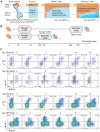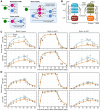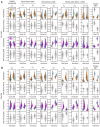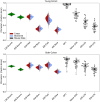The dynamics and longevity of circulating CD4+ memory T cells depend on cell age and not the chronological age of the host
- PMID: 39137219
- PMCID: PMC11321570
- DOI: 10.1371/journal.pbio.3002380
The dynamics and longevity of circulating CD4+ memory T cells depend on cell age and not the chronological age of the host
Abstract
Quantifying the kinetics with which memory T cell populations are generated and maintained is essential for identifying the determinants of the duration of immunity. The quality and persistence of circulating CD4 effector memory (TEM) and central memory (TCM) T cells in mice appear to shift with age, but it is unclear whether these changes are driven by the aging host environment, by cell age effects, or both. Here, we address these issues by combining DNA labelling methods, established fate-mapping systems, a novel reporter mouse strain, and mathematical models. Together, these allow us to quantify the dynamics of both young and established circulating memory CD4 T cell subsets, within both young and old mice. We show that that these cells and their descendents become more persistent the longer they reside within the TCM and TEM pools. This behaviour may limit memory CD4 T cell diversity by skewing TCR repertoires towards clones generated early in life, but may also compensate for functional defects in new memory cells generated in old age.
Copyright: © 2024 Bullock et al. This is an open access article distributed under the terms of the Creative Commons Attribution License, which permits unrestricted use, distribution, and reproduction in any medium, provided the original author and source are credited.
Conflict of interest statement
The authors have declared that no competing interests exist.
Figures







Update of
-
The dynamics and longevity of circulating CD4+ memory T cells depend on cell age and not the chronological age of the host.bioRxiv [Preprint]. 2024 Jun 25:2023.10.16.562650. doi: 10.1101/2023.10.16.562650. bioRxiv. 2024. Update in: PLoS Biol. 2024 Aug 13;22(8):e3002380. doi: 10.1371/journal.pbio.3002380. PMID: 38948729 Free PMC article. Updated. Preprint.
Similar articles
-
The dynamics and longevity of circulating CD4+ memory T cells depend on cell age and not the chronological age of the host.bioRxiv [Preprint]. 2024 Jun 25:2023.10.16.562650. doi: 10.1101/2023.10.16.562650. bioRxiv. 2024. Update in: PLoS Biol. 2024 Aug 13;22(8):e3002380. doi: 10.1371/journal.pbio.3002380. PMID: 38948729 Free PMC article. Updated. Preprint.
-
WASp Deficiency Selectively Affects the TCR Diversity of Different Memory T Cell Subsets in WAS Chimeric Mice.Front Immunol. 2022 Jan 18;12:794795. doi: 10.3389/fimmu.2021.794795. eCollection 2021. Front Immunol. 2022. PMID: 35116029 Free PMC article.
-
Maintenance of the human memory T cell repertoire by subset and tissue site.Genome Med. 2021 Jun 14;13(1):100. doi: 10.1186/s13073-021-00918-7. Genome Med. 2021. PMID: 34127056 Free PMC article.
-
Homeostasis and the age-associated defect of CD4 T cells.Semin Immunol. 2005 Oct;17(5):370-7. doi: 10.1016/j.smim.2005.05.007. Semin Immunol. 2005. PMID: 15964201 Free PMC article. Review.
-
Thymic commitment of regulatory T cells is a pathway of TCR-dependent selection that isolates repertoires undergoing positive or negative selection.Curr Top Microbiol Immunol. 2005;293:43-71. doi: 10.1007/3-540-27702-1_3. Curr Top Microbiol Immunol. 2005. PMID: 15981475 Review.
Cited by
-
A variational deep-learning approach to modeling memory T cell dynamics.PLoS Comput Biol. 2025 Jul 24;21(7):e1013242. doi: 10.1371/journal.pcbi.1013242. eCollection 2025 Jul. PLoS Comput Biol. 2025. PMID: 40705818 Free PMC article.
-
Tissue-resident memory CD4+ T cells are sustained by site-specific levels of self-renewal and continuous replacement.Elife. 2025 Jun 25;14:RP104278. doi: 10.7554/eLife.104278. Elife. 2025. PMID: 40560630 Free PMC article.
-
A variational deep-learning approach to modeling memory T cell dynamics.bioRxiv [Preprint]. 2025 Feb 25:2024.07.08.602409. doi: 10.1101/2024.07.08.602409. bioRxiv. 2025. Update in: PLoS Comput Biol. 2025 Jul 24;21(7):e1013242. doi: 10.1371/journal.pcbi.1013242. PMID: 40060443 Free PMC article. Updated. Preprint.
-
The impact of model assumptions in interpreting cell kinetic studies.PLoS Comput Biol. 2025 Jun 3;21(6):e1012704. doi: 10.1371/journal.pcbi.1012704. eCollection 2025 Jun. PLoS Comput Biol. 2025. PMID: 40460382 Free PMC article.
-
Asynchronous aging and turnover of human circulating and tissue-resident memory T cells across sites.Immunity. 2025 Jul 25:S1074-7613(25)00310-3. doi: 10.1016/j.immuni.2025.07.001. Online ahead of print. Immunity. 2025. PMID: 40738109
References
MeSH terms
Grants and funding
LinkOut - more resources
Full Text Sources
Medical
Research Materials

